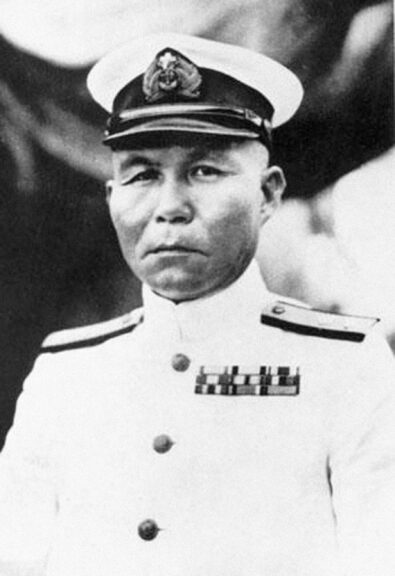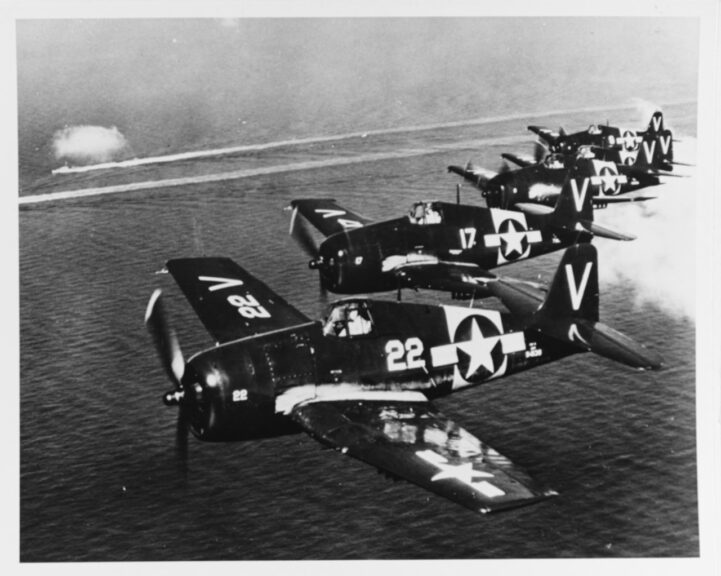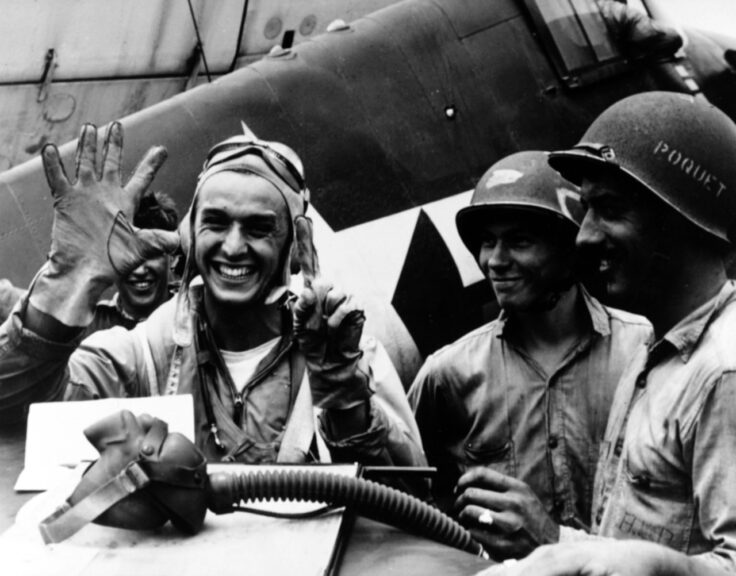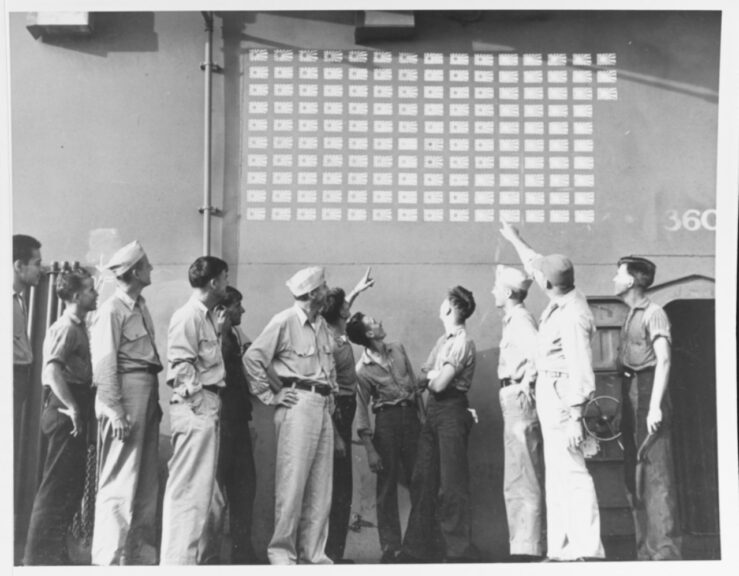While the agonizing brawl on the island of Saipan raged on, a new dimension to this titanic struggle was unfolding over the western horizon. Sailing from Tawi-Tawi in the Philippines, the Imperial Japanese Navy’s 1st Mobile Fleet, made up of almost every remaining Japanese warship, was charging headlong through the vast ocean to do battle with the U.S. fleet currently supporting the landings.
The IJN, for all its previous setbacks and attrition suffered from two years of combat with the Americans from Coral Sea and Midway and into the waters off the Solomon Islands and the Bismarck Sea, had managed to cobble together a flotilla that, on paper, was a formidable threat to the U.S. Navy.
The Japanese armada, tactically commanded by the six-foot-five and highly respected Vice-Admiral Jisaburō Ozawa, consisted of an impressive array of 62 warships, including three fleet carriers and six light carriers with a complement of 450 aircraft, five battleships, nine cruisers of all types and dozens of destroyers as well as 24 submarines. Although still outnumbered by the larger American Fifth Fleet, Ozawa planned to add additional hitting power with 300 land-based aircraft flying from airfields on the still Japanese-held Guam.

Vice-Admiral Jisaburō Ozawa, October 2, 1886 – November 9, 1966.
As with Midway (and later Leyte), the Japanese High Command fixated on fighting a Kentai Kessen (“decisive battle”) to wrest momentum from the Americans in one fell swoop. And so the mission code-named Operation A-Go, and the concept behind it, was straightforward: Destroy the American task force guarding Saipan and the Fifth Amphibious Corps would be marooned on the island. The Japanese garrison could then be sustained by the victorious IJN while the Marines and soldiers on Saipan would wither and die — ironically the same fate to which the Americans had condemned many a stranded Japanese garrison over the past two years.
On June 15, the same day Marines were storming ashore at Saipan, 1st Mobile Fleet set sail and steamed eastward towards the Marianas, passing through the San Bernardino and Surigao straits off Leyte the following day. U.S. submarines shadowed its movement and radioed the enemy’s size and heading to the overall Fifth Fleet commander, Vice-Admiral Raymond Spruance, on board his flagship, the cruiser Indianapolis. Admiral Marc Mitscher, commanding the Fifth Fleet’s fast carrier contingent designated Task Force 58, requested permission to sail west and bring his strike aircraft in range of the Japanese to beat them to the punch.

U.S. Navy Admiral Raymond A. Spruance, Vice Admiral Marc Mitscher, Fleet Admiral Chester W. Nimitz and Vice Admiral Willis A. Lee, Jr. (listed from left to right) aboard the heavy cruiser USS Indianapolis (CA-35) in February 1945. U.S. Navy photo NH 49705. Wikimedia Commons.
With 112 warships, including seven fleet carriers and eight light carriers fielding over 900 aircraft manned by well-trained and eager crews, Mitscher believed his Task Force 58 could defeat the approaching Japanese on its own. Yet, even though by the 18th the Japanese flotilla had been sighted several times, Spruance denied his request for immediate action, insisting Saipan had to be protected. Although Mitscher dutifully followed orders, many officers of Task Force 58 fumed, declaring Spruance had no guts — and worse, many felt he’d ceded the first strike, a key advantage in carrier warfare, to the Japanese. It wasn’t until the morning of the 19th that Spruance sent Fifth Fleet farther west, away from Saipan (spurring fears of abandonment by the men fighting on the island) to gain space to maneuver in the battle he knew was coming.
That same morning, Ozawa, with first strike advantage, unleashed the first of four waves of attack aircraft. At the same time Mitscher sent a detachment of fighters to intercept Japanese aircraft taking off from Guam. In a harbinger of things to come, American fliers shot down 35 Japanese planes while suffering only a single loss. When U.S. radar detected Ozawa’s first raid of 69 aircraft bearing down on Task Force 58, Mitscher ordered the fighters vectored to this new threat.

Battle of The Philippine Sea, June 1944. Ships of Japanese car. Division three under attack by TF-58 planes 20 June 1944. Photograph by aircraft of USS MONTEREY. National Archives. Wikimedia Commons.
While the air battles got underway over the Marianas themselves, the first ships lost would not be American but Japanese. Just after 9:00 a.m. the submarine Albacore slid in among 1st Mobile Fleet and sent a spread of six torpedoes towards Japan’s newest carrier and Ozawa’s flagship, the 37,000-ton Taihō, while she was launching aircraft. Though only hit once, due to poor damage-control, combustible fumes filled the vessel; it exploded five hours later and sank by the stern, taking 1,650 crewman with her. Ozawa survived and transferred his flag to the destroyer Wakatsuki. Four hours after Albacore attacked, another U.S. submarine, Cavalla, torpedoed the 32,000-ton fleet carrier Shōkaku while she was recovering surviving aircraft from the first strike, sending her bow-first to the bottom with 1,272 of her crew. It was an outstanding showing from the formidable U.S. “silent service.”

Japanese Zeros on the flight deck of the HJMS Shokaku Japanese aircraft carrier just before the Battle of Santa Cruz. (Photo by © CORBIS/Corbis via Getty Images)
While these dramatic events were taking place away from Task Force 58, waves of Japanese aircraft headed for the American ships. Confidence was high among Ozawa’s airmen. But that confidence would soon be shattered as the greatest naval aerial battle in history exploded over the Philippine Sea.
While still dozens of miles from any vessels, swarms of American F6F Hellcat interceptors, guided by advanced radar and highly competent Fighter Director Officers, and flown by far better-trained pilots, were up at altitude waiting for the incoming enemy squadrons. The magnificent Grumman-built fighters were among the new generation of U.S. combat aircraft and, unlike their antecedent F4F Wildcats, were markedly superior to the once-invincible Mitsubishi A6M Zeros, whose inadequately-trained pilots tried in vain to escort their comrades’ dive bombers and torpedo bombers as they struggled to even reach the U.S. fleet. At 10:25 a.m. the Hellcats winged over and pounced on their hopelessly outclassed, if brave, foes.

F6F “Hellcat” fighters In formation, during the later 1940s. Plane in foreground is BuNo 94139, an F6F-5. Catalog #: 80-G-428464. National Archives. Naval History and Heritage Command.
What followed was, quite simply, a massacre. In the rolling aerial dogfights that raged over the course of the day, 1st Mobile Fleet’s four Japanese strike packages were mercilessly savaged by the U.S. Hellcats, sending one Japanese plane after another spinning in flames into the ocean. By the time the U.S. fliers had easily beaten away the last attack, literally hundreds of flaming, oily wrecks of Japanese aircraft and dead crew littered the waters along thirty-five miles of open ocean leading up to the American task force. Several U.S. pilots in this lop-sided victory became an “ace in a day”. (The unofficial sobriquet “fighter ace” goes to a pilot who downs five or more enemy aircraft in air-to-air combat.)
One example was 25-year-old Lt. Alex Vraciu leading his squadron off the Lexington. Right after take-off his Hellcat began spitting oil onto his windscreen and refused to go to full power. Not only that, the deck crew had neglected to lock the safety pins to his folding wings, preventing him from engaging in any wild maneuvering. Nevertheless, in an impressive show of marksmanship, Vraciu managed to down six enemy planes in just eight minutes while only expending 362 rounds of ammunition.

Lieutenant Junior Grade Alexander Vraciu, USNR; fighting squadron 16 “Ace”, holds up six fingers to signify his “kills” during the “Great Marianas Turkey Shoot”, on 19 June 1944. USS LEXINGTON. National Archives. Naval History and Heritage Command.
Sources vary, but by the end of the day, it is safe to say of the roughly 450 Japanese warplanes Ozawa sent into battle, only 100 fit for duty remained. His losses in personnel were in the many hundreds. In return, a Japanese bomber scored a single hit on the battleship South Dakota. For their troubles the Americans lost 23 planes in air-to-air combat and another six from accidents with 27 KIA. Following the one-sided battle the jubilant fliers retired to their wardrooms to count up their kills. In Fighting Squadron 16’s ready room aboard Lexington, one pilot offered “Why, hell, it was just like an old-time turkey shoot back home!” And thus was this phase of the battle forever etched into the history books as “The Great Marianas Turkey Shoot.”

USS LEXINGTON. Officers and crewman admire Japanese flags painted on the carrier’s island, commemorating 143 “kills” claimed by her air group sixteen. Photographed 21 June 1944, immediately after The Battle of The Philippine Sea. National Archives. Naval History and Heritage Command.
For the Japanese mourning the loss of so many pilots and planes, June 19, 1944 was a catastrophe. In one day, the IJN’s air power had been decimated. Once more transferring his flag to the fleet carrier Zuikaku—the last surviving carrier of the Pearl Harbor attack—Ozawa directed his ships to steam north until out of range of U.S. aircraft. Mistakenly believing that many of his planes that did not return had landed on Guam, Ozawa planned to refuel and then go back into action. But the following day, June 20, Ozawa’s hope for victory disappeared due to Mitscher making one of the most daring, and painful, decisions of any admiral in any action in the Pacific. And the stage was set for one of the most dramatic episodes in the annals of naval warfare.
* * *
RELATED: The Battle Of Saipan, Part One: Invasion
* * *
Brad Schaeffer is a commodities trader, columnist, and author of two acclaimed novels. Along with Daily Wire, his articles have appeared in the Wall Street Journal, New York Daily News, New York Post, National Review, The Federalist, The Hill and other media outlets. His newest book, LIFE IN THE PITS: My Time as a Trader on the Rough-and-Tumble Exchange Floors, is a fun and informative memoir of his time as a floor trader in Chicago and New York. You can also find more of Brad’s articles on Substack.
The views expressed in this piece are those of the author and do not necessarily represent those of The Daily Wire.
Correction: An earlier version of this article contained a photo of the F4F Wildcat fighter plane. The actual plane used was a F6F Hellcat fighter.

Continue reading this exclusive article and join the conversation, plus watch free videos on DW+
Already a member?

